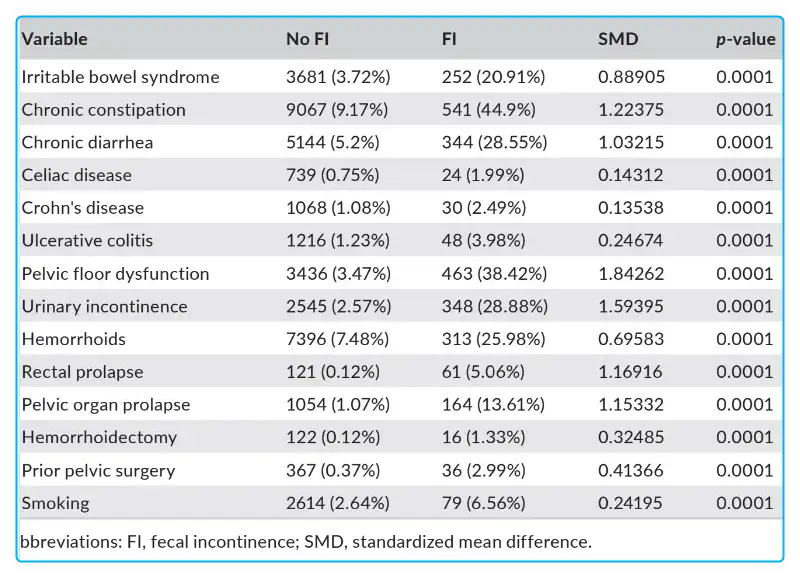People with new fecal incontinence are 1.9 X more likely to have low Vitamin D
The association between vitamin-D deficiency and fecal incontinence
Neurogastroenterol Motil 2024 Feb 5:e14753. doi: 10.1111/nmo.14753 PDF can be viewed at DeepDyve
Leila Neshatian 1, Gabrielle Grant 2, Nielsen Fernandez-Becker 1, Ye Yuan 3, Patricia Garcia 1, Laren Becker 1, Brooke Gurland 4, George Triadafilopoulos 1

Background: Vitamin-D is essential for musculoskeletal health. We aimed to determine whether patients with fecal incontinence (FI): (1) are more likely to have vitamin-D deficiency and, (2) have higher rates of comorbid medical conditions.
Methods: We examined 18- to 90-year-old subjects who had 25-hydroxy vitamin-D levels, and no vitamin-D supplementation within 3 months of testing, in a large, single-institutional electronic health records dataset, between 2017 and 2022. Cox proportional hazards survival analysis was used to assess association of vitamin-D deficiency on FI.
Key results: Of 100,111 unique individuals tested for serum 25-hydroxy vitamin-D, 1205 (1.2%) had an established diagnosis of FI. Most patients with FI were female (75.9% vs. 68.7%, p = 0.0255), Caucasian (66.3% vs. 52%, p = 0.0001), and older (64.2 vs. 53.8, p < 0.0001).
Smoking (6.56% vs. 2.64%, p = 0.0001) and
GI comorbidities, including
constipation (44.9% vs. 9.17%, p = 0.0001),
irritable bowel syndrome (20.91% vs. 3.72%, p = 0.0001), and
diarrhea (28.55% vs. 5.2%, p = 0.0001)
were more common among FI patients.
Charlson Comorbidity Index score was significantly higher in patients with FI (5.5 vs. 2.7, p < 0.0001). Significantly higher proportions of patients with FI had vitamin-D deficiency (7.14% vs. 4.45%, p < 0.0001). Moreover, after propensity-score matching, rate of new FI diagnosis was higher in patients with vitamin-D deficiency; HR 1.9 (95% CI [1.14-3.15]), p = 0.0131.
Conclusion & inferences: Patients with FI had higher rates of vitamin-D deficiency along with increased overall morbidity. Future research is needed to determine whether increased rate of FI in patients with vitamin-D deficiency is related to frailty associated with increased medical morbidities.
23 References
Bharucha AE, Knowles CH, Mack I, et al. Faecal incontinence in adults. Nat Rev Dis Primers. 2022;8:53.
Bharucha AE, Zinsmeister AR, Locke GR, et al. Risk factors for fecal incontinence: a population-based study in women. Am J Gastroenterol. 2006;101:1305-1312.
Bharucha AE, Zinsmeister AR, Schleck CD, Melton LJ III. Bowel disturbances are the most important risk factors for late onset fecal incontinence: a population-based case-control study in women. Gastroenterology. 2010;139:1559-1566.
Blomquist JL, Muñoz A, Carroll M, Handa VL. Association of Delivery Mode with Pelvic Floor Disorders after Childbirth. JAMA. 2018;320:2438.
Nygaard I. Prevalence of symptomatic pelvic floor disorders in US women. JAMA. 2008;300:1311-1316.
Ditah I, Devaki P, Luma HN, et al. Prevalence, trends, and risk factors for fecal incontinence in United States adults, 2005-2010. Clin Gastroenterol Hepatol. 2014;12:636-643.e2.
Oblizajek NR, Gandhi S, Sharma M, et al. Anorectal pressures measured with high-resolution manometry in healthy people-normal values and asymptomatic pelvic floor dysfunction. Neurogastroenterol Motil. 2019;31:e13597.
Charlson ME, Carrozzino D, Guidi J, Patierno C. Charlson comorbidity index: a critical review of clinimetric properties. Psychother Psychosom. 2022;91:8-35.
Goode PS, Burgio KL, Halli AD, et al. Prevalence and correlates of fecal incontinence in community-dwelling older adults. J Am Geriatr Soc. 2005;53:629-635.
Wiedmer P, Jung T, Castro JP, et al. Sarcopenia-molecular mechanisms and open questions. Ageing Res Rev. 2021;65:101200.
Xue QL. The frailty syndrome: definition and natural history. Clin Geriatr Med. 2011;27:1-15.
Neshatian L, Lam JP, Gurland BH, Liang T, Becker L, Sheth VR. MRI biomarker of muscle composition is associated with severity of pelvic organ prolapse. Tech Coloproctol. 2022;26:725-733.
Halfon M, Phan O, Teta D. Vitamin d : a review on its effects on muscle strength, the risk of fall, and frailty. Biomed Res Int. 2015;2015:1-11.
Michelson JD, Charlson MD. Vitamin d status in an elective orthopedic surgical population. Foot Ankle Int. 2016;37:186-191.
Badalian SS, Rosenbaum PF. Vitamin d and pelvic floor disorders in women: results from the National Health and nutrition examination survey. Obstet Gynecol. 2010;115:795-803.
Alkhatib AA, Tuteja AK. High prevalence of vitamin d deficiency among patients with fecal incontinence. Dig Dis Sci. 2010;55:3632-3633.
Parker-Autry CY, Gleason JL, Griffin RL, Markland AD, Richter HE. Vitamin d deficiency is associated with increased fecal incontinence symptoms. Int Urogynecol J. 2014;25:1483-1489.
Staller K, Song M, Grodstein F, et al. Increased long-term dietary fiber intake is associated with a decreased risk of fecal incontinence in older women. Gastroenterology. 2018;155:661-667.e1.
Yang K, Tabung FK, Whitehead WE, Giovannucci EL, Chan AT, Staller K. Proinflammatory diet is associated with increased risk of fecal incontinence among older women: prospective results from the Nurses' Health Study. Clin Gastroenterol Hepatol. 2023;21:1657-1659.e3.
Staller K, Song M, Grodstein F, et al. Physical activity, BMI, and risk of fecal incontinence in the Nurses' Health Study. Clin Transl Gastroenterol. 2018;9:e200.
Girgis CM. Vitamin d and skeletal muscle: emerging roles in development, anabolism and repair. Calcif Tissue Int. 2020;106:47-57.
Girgis CM, Clifton-Bligh RJ, Hamrick MW, Holick MF, Gunton JE. The roles of vitamin d in skeletal muscle: form, function, and metabolism. Endocr Rev. 2013;34:33-83.
Gonçalves de Carvalho CMR, Ribeiro SML. Aging, low-grade systemic inflammation and vitamin d : a mini-review. Eur J Clin Nutr. 2017;71:434-440.
VitaminDWiki – Overview Gut and vitamin D has
{include}
VitaminDWiki – Overview Gut and vitamin D contains gut-friendly information
{include}
VitaminDWiki – Gut category listing contains
{include}
VitaminDWiki – Irritable Bowel Syndrome and Vitamin D - many studies
VitaminDWiki – Constipation - Magnesium, Calcium and cofactors
Note: Vitamin D both consumes Magnesium and Increases Calcium
